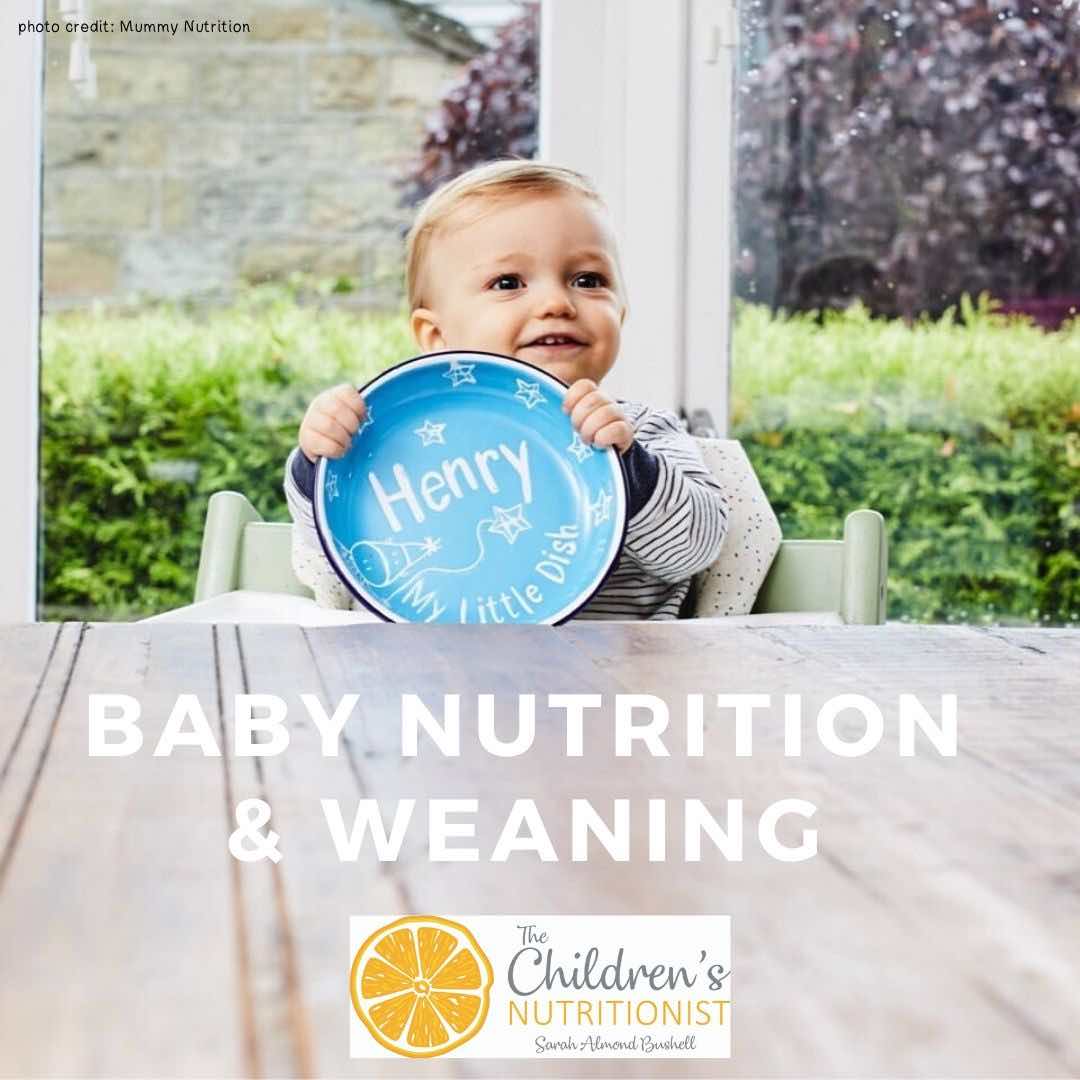
Knowing how to meet baby’s nutrition in the first year of life doesn’t have to be challenging. Use these tips to know what your baby’s first foods can be!
After breastfeeding or bottle-feeding exclusively for 6 months, you’ll be anxious to get feeding started. Although starting solids is an exciting time for first-time families, it can be daunting trying to decide how and when to start. You’ll get plenty of advice from well-intentioned moms on the best way to introduce solids, but you’ll want to make sure you’re using the latest guidelines. Have no fear – SuperKids Nutrition is here! Check out our summary first, Infant Nutrition – Your Baby’s First Foods, then head back here for all the details!
Recommendations for Baby’s First Foods
As a general recommendation we suggest waiting until 6 months or when your baby is developmentally ready to start solids. Earlier feeding is associated with an increased risk of childhood obesity. However, there are individual circumstances where recommendations may vary. Work with your pediatrician and dietitian as indicated.
|
Physical & Developmental Milestones |
Recommended Foods |
Suggested Portion Guidelines (babies eat intuitively) |
|
|
0 – 4 months |
– Tongue thrust (a) – Rooting reflex (b) – Suck reflex (c) – Swallowing reflex |
– Breastmilk (d) OR – Iron-fortified infant formula |
– Infant should feed on demand about 8-12 times per day up to 24-30 oz. daily (1) – Newborns usually drink 2-3 oz. per pound of body weight (e) – Timing for feeding varies with each infant. Newborns often need to nurse on each breast. A general guideline is 10-15 minutes on each breast |
|
4 – 6 months |
– Birth weight has doubled – Can sit with minimal support – Good head control – Ready for highchair – Swallows better – Can close mouth around age-appropriate soft spoon – Can move food from front to back of mouth – Disappearance of tongue-thrust reflex – Able to grasp objects voluntarily – Learning to reach mouth with hands – Shows interest in food or acts hungry after breastfeeding |
– Breastmilk or iron-fortified infant formula (3) – The American Academy of Pediatrics recommend starting solids at 6 months, not before. If your child is showing delays in readiness work with your pediatrician and get a referral to a pediatric dietitian. Delaying feeding can increase the risk of food allergies, and feeding too early can increase risk of childhood obesity. |
– 4-6 oz. breastmilk or formula per feeding (2) |
|
6 – 8 months |
– Able to clear the spoon with upper lip – Sits independently – Independently picks up and holds objects in hand – Begins to finger feed |
– Breastmilk or iron-fortified infant formula – Grains: iron-fortified mixed with breastmilk; check to make sure it is a single-ingredient product to decrease the risk of allergic reactions (4); bread, small pieces of crackers – Vegetables: cooked; plain; strained, pureed, or mashed – Fruits: plain; strained, pureed, or mashed – Meats: plain; strained, pureed, or mashed; turkey, chicken, beef, eggs, cheese, yogurt (no cows milk until 12 months), mashed legumes; provides zinc and iron (f) that your baby needs. – Other: Eggs and peanut butter can also be introduced and may lower risk of food allergy later. Learn exactly when to introduce peanuts and why it’s important. |
– 6-8 oz. every 4-5 hours for a total of 24-32 oz. per day (2,5) – Give some breastmilk or formula first, then try solid foods. Finish up the feeding session with more breastmilk or formula. – Infants intake of breast milk/or formula may decrease as food intake increases – 1-2 tablespoons of solids once a day building up to twice per day (6) – 1-2 oz. grains (7) – 2-4 oz. of vegetables and/or fruit twice daily – 1-2 oz. meat or another protein source (ex. tofu, egg) once daily |
|
8 – 10 months |
– Demonstrates the pincer grasp (h) – Holds bottle without help – Holds spoon with or without help – May drink from a cup with help – Beginning to use jaw to mash food |
– Breastmilk or iron-fortified infant formula – Grains: iron-fortified; whole-grain: crackers, bread, noodles, tortilla – Vegetables: cooked; finely chopped or diced – Fruits: finely chopped or diced – Meat: ground, finely chopped, or diced; includes poultry, eggs, and mashed legumes (5) |
– 24-32 ounces per day – Solids 3 times per day (breakfast, lunch, dinner) – 2-4 oz. grains per day – 2-4 oz. meat per day – 4-6 oz. vegetables per day – 4-6 oz. fruit per day |
|
10 – 12 months |
– Picks up food and feeds self – Drinks from cup – Begins to use spoon and fork |
– Breastmilk or iron-fortified infant formula – Grains: iron-fortified; crackers; bread; noodles; tortilla – Vegetables: cooked; finely chopped or diced – Fruits: finely chopped or diced – Meat: ground, finely chopped, or diced; includes poultry, eggs, and mashed legumes |
– 18-24 ounces per day – Offer whole grains 2-3 times per day – 2-4 oz. grains per day – 2-4 oz. meat per day – 4-6 oz. vegetables per day – 4-6 oz. fruit per day – 3 meals and 2 snacks/day |
Now that you’ve got the details down on what, when and how for your baby’s first foods, learn more with our dos, don’ts for the first year of life with Baby Feeding Tips from 0-12 Months Old, and Rethinking Baby Food: 7 Meals the Whole Family Can Enjoy.
Baby Nutrition & Baby-Led Weaning Course Recommendation
If you’re interested in learning more about baby’s first foods and baby-led weaning, Registered Dietitian Sarah Almond Bushell offers a fantastic course. She’ll lead you through the minefield of information and further address questions like “When do I start?”, “Is baby-led weaning or purees best?”, and “How can I prevent choking?”. For more information and support check out The Children’s Nutritionist Baby Nutrition & Weaning Course*.
*If you purchase the course through our link we’ll receive a percentage of the sale at no extra cost to you.
Glossary
a The tongue thrust is when the infant’s tongue automatically pushes forward and outside of the mouth when her lips are touched. This reflex helps the infant feed from the breast or the bottle but inhibits spoon-feeding.
b The rooting reflex is also referred to as the “search reflex”. This reflex occurs when the infant’s cheek is stroked, causing the infant to turn to the side touched, open her mouth, and seek nourishment via sucking.
c The suck reflex happens when the roof of the baby’s mouth is touched, resulting in a sucking motion. This reflex develops around the 32-36th week of pregnancy (1)
d The American Academy of Pediatrics (AAP) recommends exclusive breastfeeding for about 6 months of life and to continue until 1 year or longer if mutually desired by mother and baby (2).
e Suggested feedings per day & total volume (ounces/day) are estimated intake amounts. Please listen & follow your baby’s hunger and fullness cues.
f The DRI for iron for full-term infants is 15 mg/day (3). Exclusively breastfed infants are at risk for developing iron-deficiency anemia by 6 months of age. An average of 2 servings is needed to meet this daily iron requirement.
g One serving size is equivalent to 1-2 tablespoons.
h Pincer Grasp: Uses thumb and index finger to pick up objects.










